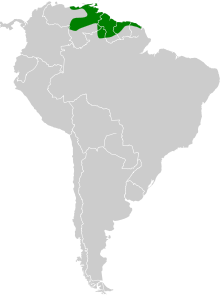White-chested emerald
| White-chested emerald | |
|---|---|
.jpg) | |
| Scientific classification | |
| Kingdom: | Animalia |
| Phylum: | Chordata |
| Class: | Aves |
| Order: | Trochiliformes |
| Family: | Trochilidae |
| Genus: | Amazilia |
| Species: | A. brevirostris |
| Binomial name | |
| Amazilia brevirostris (Lesson, 1829) | |
 | |
| White-chested Emerald range | |
| Synonyms | |
|
Amazilia chionopectus | |
The white-chested emerald (Amazilia brevirostris) is a hummingbird found in eastern Venezuela, the Guianas, Trinidad and far northern Brazil (Roraima). It has sometimes been placed in the genus Agyrtria, and the name A. chionopectus was formerly used for this species, as the name A. brevirostris was believed to be applicable to the versicoloured emerald. While most current authorities maintain the view that A. brevirostris is the correct name for the white-chested emerald, it has recently been suggested that this is incorrect, in which case its scientific name would revert to A. chionopectus.
It is a widespread and common species in Trinidad, less so in Venezuela. It appears to be a local or seasonal migrant, although its movements are not well understood. It is a bird of cultivation, woodland and forest. The female lays her eggs in a small cup nest made of plant fibre and placed on a horizontal tree branch.
The white-chested emerald is approximately 9 cm long and weighs 4.7 g. The black bill is straight and fairly long, at nearly 2 cm. It has bright golden-green upperparts, becoming bronze on the tail, white underparts, and its flanks are green, or white spotted with green. The tail is tipped with purple-black. The sexes are similar.
White-chested emeralds feed on nectar, usually taken from the flowers of large trees, but sometimes from smaller plants such as Heliconia. They also take small insects. The song of this species is a churring tche-tche-tche-tche-tche.
References
- ↑ BirdLife International (2012). "Amazilia brevirostris". IUCN Red List of Threatened Species. Version 2013.2. International Union for Conservation of Nature. Retrieved 26 November 2013.
- French, Richard (1991). A Guide to the Birds of Trinidad and Tobago (2nd ed.). Comstock Publishing. ISBN 0-8014-9792-2.
- Hilty, Steven L (2003). Birds of Venezuela. London: Christopher Helm. ISBN 0-7136-6418-5.
- Chebez, J. C., R. Castillo, R. Güller, & L. Castillo. (2008). Sobre la situación taxonómica de Amazilia brevirostris (Lesson, 1829) y su presencia en la Argentina. Las Ciencias 1: 67-81.
External links
- White-chested Emerald Humming Bird: Georgetown, Guyana
- White-chested Emerald videos on the Internet Bird Collection
- Stamps (for Trinidad and Tobago) with RangeMap
- White-chested Emerald photo gallery VIREO Photo-High Res
